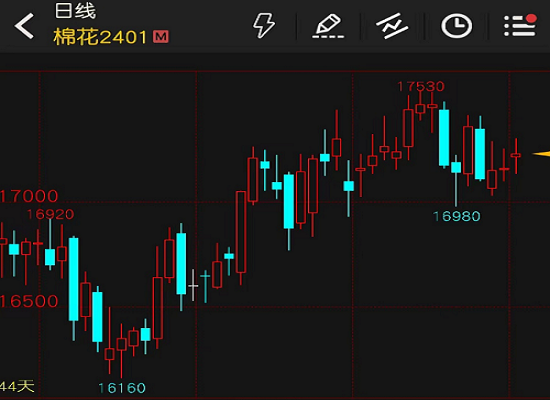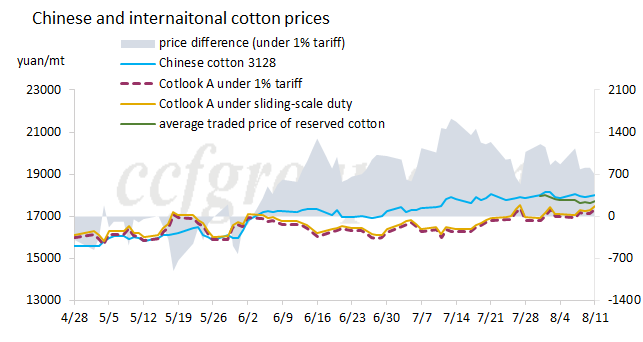Chinese cotton: what factors should be monitored later?
In Aug, ZCE cotton futures market sees two large declines on Aug 2-3 and Aug 8. Though the major influencing factor is macro economy, it can be seen that some long positions take profits and after Aug 8, ZCE cotton also sees several times of decline from high level. Meanwhile, through the communications with market participants, it is understood that market sentiment towards cotton is not as bullish as before. However, it may still be too early to say ZCE cotton has reversed its trend. Therefore, when it comes to judging Chinese domestic cotton prices, it is necessary to pay attention to several key factors: spot cotton supply, expectations for new cotton, and downstream demand. These factors will be analyzed.

First, let's see the recent market situation. On Jul 31, ZCE cotton rose sharply, as the trading prices of reserved cotton were expected to be high after the close of futures and downstream market improved somewhat during Jul 24 and Jul 28 in Nantong and Guangdong. After the close of futures, spinners were indeed active to purchase reserved cotton, and the trading prices of reserved cotton reached 17,961yuan/mt. But during the night trading session, ZCE cotton had not risen largely as expected, which was dull to rise somewhat. On Aug 2, Fitch cut U.S. credit rating to AA+ from AAA and stated that U.S. financial status might continue to deteriorate in the next three years. U.S. stocks market slumped then and most commodity prices were sharply lower, as well as ICE and ZCE cotton futures. ZCE major cotton contract, Jan contract, once declined by 400yuan/mt to dip below 17,000yuan/mt. On Aug 4, U.S. non-farm payroll employment was released, up by 187,000 in July, lower than the expected 200,000 and previous value of 209,000, US dollar index declined largely, and ZCE cotton futures started to increase. On Aug 8, China's exports were 14.5% lower year on year and imports were 12.4% lower in Jul, and ZCE cotton declined in the afternoon. In addition to the macro aspect, some long positions started to take profits. Cotton prices were range-bound again and saw more declines from high level.
Next, let's see the major influencing factors on cotton prices later: spot cotton supply, expectations for new cotton, and downstream demand.
1. Spot cotton supply
The significant price increases of ZCE cotton from June to July were closely related to market rumors of low inventory levels in Xinjiang's warehouses. As a result, measures were taken to alleviate supply shortages. The state cotton reserves sales policy was released on Jul 18 and the 750kta sliding-scale duty quotas were announced to be allocated on Jul 21.
In terms of the state cotton auction, from Jul 31 to Aug 10, 90kt of reserved cotton was planned to be sold, and if the daily selling volumes keep 10kt and are fully transacted, by end Aug, 240kt of reserved cotton was sold, which could ease the supply tightness somewhat. But if the state cotton auction ends in end Aug and mid-Sep, it will only provide a moderate alleviation to the spot supply. If the state cotton auction continues in Sep and Oct, assuming a daily selling volume of 10kt and full transactions, a total of 440kt will be released by the end of Sep, and a total of 630kt will be released by the end of Oct. This will have a more noticeable effect in relieving the tightness of the spot market supply.
For cotton quotas, the quantity of quotas under 1% tariff is 894kt in 2023 and with the 750kt of sliding-scale duty quotas, the total quotas are 1.644 million tons. If the quotas are fully used, the supply tightness will be improved apparently, but the usage of quotas depends on the price difference between Chinese and international cotton. If international cotton prices are firmer later and price difference narrows within 500yuan/mt, then the imported cotton supply may be limited. Besides, in terms of the cotton imports in recent months, cotton imports may remain below 100kt in Jul, and recover somewhat in Aug. The yearly growth of cotton imports in 2023/24 season is needed to see the price difference between Chinese and international cotton.
Therefore, from the perspective of spot supply, the state cotton auction and the allocation of cotton quotas have to some extent mitigated the domestic supply tightness. However, the short-term cotton prices still have support, and the impact of further state cotton auction and quotas will depend on the duration of the auction and the price difference between Chinese and international cotton. These factors need to be monitored in the future.

2. Expectations for new cotton
From Apr 2023, there were gradual expectations of lower 2023/24 Xinjiang cotton production and competition for seed cotton procurement in the second half year. In terms of current situation, the low temperature in Apr and May has great impact on the cotton crops in Kuqa and Korla, while in Kashgar, cotton crop develops well. Besides, the high temperature in Jul affects much on the cotton crops in North Xinjiang. 2023/24 Xinjiang cotton production is very likely to reduce, while the yearly decline is hard to say, which is needed to pay attention to the weather condition and actual procurement later. Moreover, due to the excessive ginning capacity in Xinjiang, there is strong expectation of competition for seed cotton in new season. Currently, the mainstream purchase prices of seed cotton is 7.5-8.5yuan/kg and new cotton costs are about 17,000-20,000yuan/mt. If the seed cotton purchase prices are within 8yuan/kg, new cotton costs are below 19,000yuan/mt. Currently, ZCE cotton is 17,000-17,200yuan/mt and spot cotton prices are around 18,000yuan/mt. If new seed cotton prices can be within 8yuan/kg with ginning yield of 40%, new cotton costs will be settled soon, and ZCE cotton futures may reflect actively and then be plain. If the seed cotton prices are higher, ZCE cotton may go upward further.
3. Downstream demand
Starting from the week of Jul 24 to 28, downstream demand showed some improvement. The home textile market in Nantong is still performing better than the clothing market in Guangdong. Some spinning mills in inland have also received some export orders. However, feedback suggests that the order volume from home textile end brands has significantly decreased compared to normal levels and the trading volumes in the Guangdong market has also experienced a large year-on-year decline, and currently, there is a limited variety of products being sold. Concerns still exist regarding the continuity, duration, and recovery scale of downstream demand during the peak season. Looking at the current situation of theoretical spot profit for spinners in inland, spinners have been facing theoretical losses of more than 1,500yuan/mt for nearly a month and a half. Therefore, even though there has been some improvement in downstream demand lately, some small and medium-sized spinners are still gradually reducing their operating rates. There is insufficient driving force from downstream for further price increases in cotton.
In summary, after entering Aug, market sentiment towards domestic cotton prices is not as bullish as before. However, there are still uncertainties surrounding factors such as the duration of state cotton auction, the increase in cotton imports, the reduction in new cotton production, and the purchase prices of seed cotton. In the short term, cotton prices still have strong support. However, it is still necessary to monitor macroeconomic changes in the short term. If macroeconomic risks increase significantly, there is also a considerable risk of further correction in cotton prices. In the medium term, there is a high probability that the cotton price will reach a temporary peak after the purchase price of seed cotton, which represents the cost of new cotton, is determined.
- Top keywords
- Cotton Price
- Cotton Futures Price
- Cotton Futures
- CZCE
- PTA Futures Price
- Chemical Fiber
- Polyester Prices
- Wool price
- PTA Futures
- Shengze Silk
- China
- Yarn Price
- price
- China Textile City
- Fibre Price
- Benzene Price
- Cotton
- Index
- Cotton Index
- PTA
- fabric price
- NYMEX
- Top 10
- textile industry
- Spot Cotton
- Cotton Yarn
- Polyester Price
- Futures
- PTA Price
- cotton yarn price

